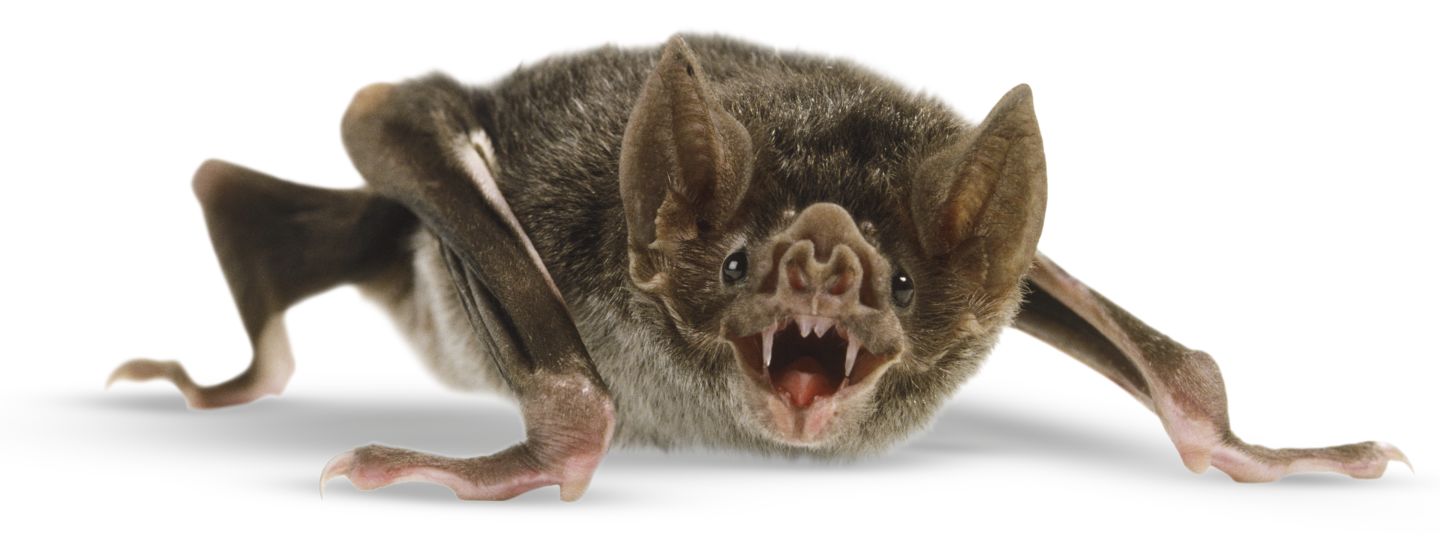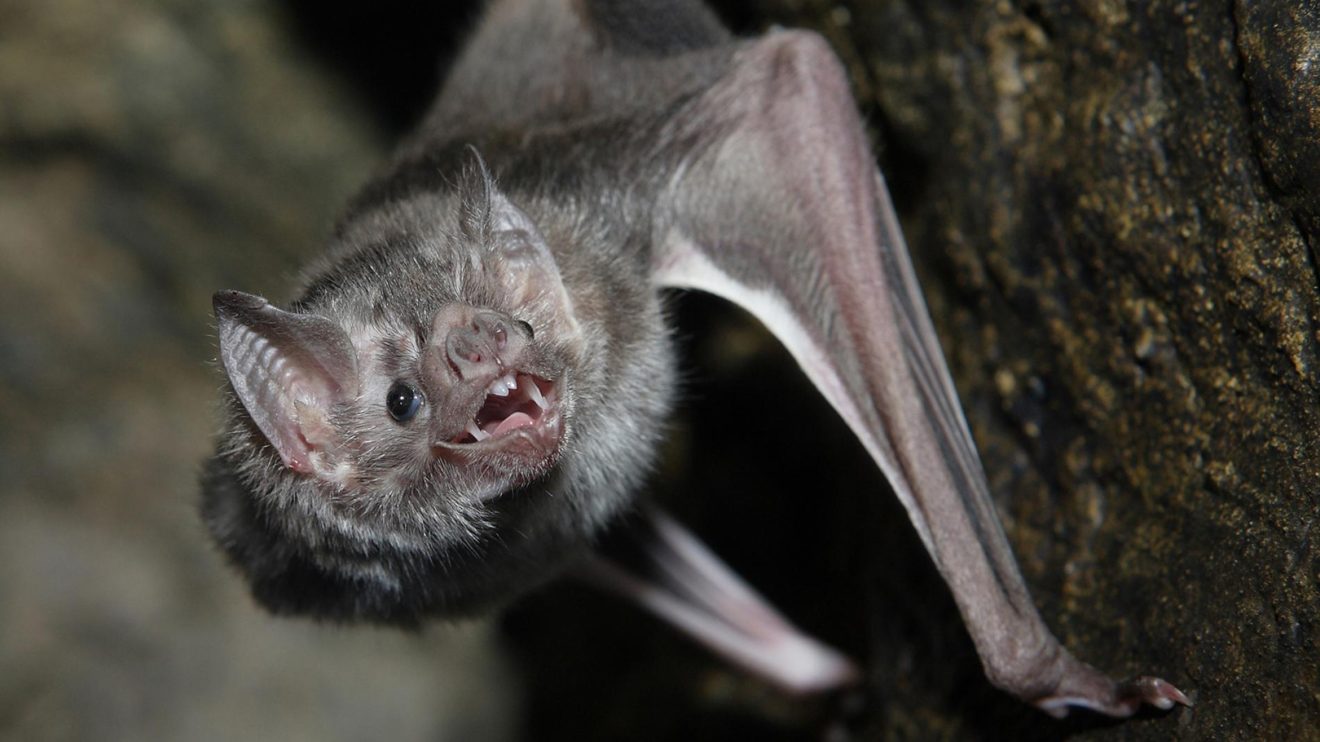Bats are the only mammals that can fly, but vampire bats, species of the subfamily Desmodontinae have an even more interesting distinction—they are the only mammals that feed entirely on blood. There are three species: the Common Vampire Bat, the White-winged Vampire Bat and the Hairy-legged Vampire Bat, but only the first two species are found in Guyana.
Vampire bats can live for up to 12 years in the wild, although captive individuals have been known to reach the age of 19. For such a small animal, vampire bats are surrounded by unique and interesting characteristics that make them a fascinating animal.
Description Of Vampire Bats

The Vampire Bat | dkfindout.com
Vampire bats have short, conical muzzles. It also lacks a nose leaf, instead having naked pads with U-shaped grooves at the tip. It has front teeth that are specialized for cutting and the back teeth are much smaller than in other bats. The part of the bat’s brain that processes sound, is well adapted to detecting the regular breathing sounds of sleeping animals that serve as its main food source. Vampire bats can walk, jump, and even run by using a unique, bounding gait, in which the forelimbs instead of the hind limbs are recruited for force production, as the wings are much more powerful than the legs. Vampire bats use infrared radiation to locate blood hotspots on their prey.
Habitat Of Vampire Bats
Vampire bats are found in caves, mines, hollow trees and abandoned buildings in tropical and subtropical areas. Countries where they can be found in abundance include Mexico, Brazil, Chile and Argentina. They can live at altitudes as high as 7,800 feet. Vampire bats live together in what is known as a colony. The size of the colony is usually around 100, but there have been reports of colonies containing as many as 1,000 bat members. While the bats live together, they hunt alone. These notorious bats sleep during the day in total darkness, suspended upside down from the roofs of caves.
Diet Of Vampire Bats
Their sole food source is blood. This is a dietary trait known as hematophagy. There are only three bat species that feed on blood, including the vampire bat. In captivity, vampire bats are fed beef blood.
Behavior Of Vampire Bats
Vampire bats live in dark caves and tree hollows. They spend the daylight hours sleeping upside down. They do this not only for protection, but because this is the only way that a bat can take off in flight. Their wings are not able to lift them when they are an upright position. Bats only emerge during the darkest hours of the night.
Reproduction Of Vampire Bats
A male vampire bat will mate all year. Once a female is pregnant, she will give birth after seven months and will care for the offspring for five months. During this time, the baby bat consumes its mother’s milk until its old enough to consume a liquid diet of blood.
Female vampire bats display a rare behavior called “alloparenting” in which females will feed young bats whose mothers have died, as well as those whose mothers are still alive.
7 Interesting Facts About Vampire Bats
- Vampire Bats Are the Only Bats to Adopt Offspring. Mother vampire bats will only leave their young to hunt. If, for whatever reason, the mother does not return, other female vampire bats will care for the baby bat until it is old enough to be on its own. This care includes grooming and feeding. No other species of bats have been observed doing this.
- Drugs Have Been Developed That Mimic Vampire Bat Saliva. Scientists saw promise in the clot preventing chemicals in a vampire bat’s saliva that is used during feeding. Drugs with similar properties were invented to help prevent blood clots in patients with heart conditions and stroke symptoms.
- Vampire Bats Have Amazing Senses. Vampire bat facts tell us that, despite popular beliefs, vampire bats can see and hear with amazing accuracy. They also have a specialized sensor near their nose that helps them find a food source. The sensor is extremely sensitive to heat and allows the bat to easily tell the different between skin that is covered in thick hair and skin that is covering a blood vessel.
- A Vampire Bat Can Ingest 40% of Its Weight during One Feeding Session. Vampire bats need to eat every two days, and a typical feeding session lasts for 20 minutes. A vampire bat is usually so bloated after eating that it needs to propel its body with extra force to fly back to its home. A colony of vampire bats can drink the blood of 25 cows within one year.
- Vampire Bats Are Incredibly Social. They share a strong family bond within their colonies. If a fellow member is unable to find a source of food for the evening, it may head back to the colony and beg other members for food. Vampire bats are able to regurgitate some of their own consumed blood and share with the hungry bat. Vampire bats also participate in what is known as social grooming. Females will groom their own and others’ offspring, and also each other.
- Vampire bats are totally unable to utilize any other source of food than blood. In fact if they don’t drink blood for 48 hours, they will starve to death.
- Although vampire bats have actually got twenty teeth, only the very front incisors are used.
About Vampire Bats
They are from the species of the subfamily Desmodontinae. They are the only mammals that feed entirely on blood. There are three species: the Common Vampire Bat, the White-winged Vampire Bat and the Hairy-legged Vampire Bat, but only the first two species are found in Guyana. They are very social. Unlike other bats, vampire bats can walk, run and even jump.








1 Comment